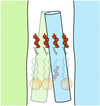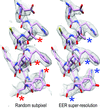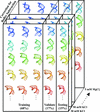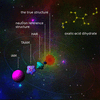issue contents
September 2020 issue

editorial
MATERIALS | COMPUTATION
This editorial gives a brief discussion of the current status and role of computational modelling as a technique in structural science.
scientific commentaries
CRYO | EM
Electron-event representation saves the spatial and temporal coordinates of every electron with ultimate accuracy. Through maximum signal extraction, it will improve the performance of electron cryo-microscopy.
MATERIALS | COMPUTATION
Maynard-Casely and co-workers [IUCrJ (2020). 7, 844–851.] investigate two of Pluto's most abundant minerals with neutron diffraction. The new results will be key to understanding the geology of our distant neighbour and represent a significant advance in the emerging field of small-molecule geology.
research papers
BIOLOGY | MEDICINE
A large portion of the research community concerned with high data-rate macromolecular crystallography has agreed to an updated specification of data and metadata for diffraction images to be produced at light sources to facilitate the processing of data sets and to enable data archiving according to FAIR principles. Here, the resulting standard is presented.
NEUTRON | SYNCHROTRON
In this article, move contrast X-ray imaging (MCXI) based on high-brightness synchrotron radiation is developed. Experiments with live rodents demonstrate the practicability of the MCXI method for sensitive and intact imaging of microvessels in vivo.
NEUTRON | SYNCHROTRON
Polarized neutron diffraction on the flipping-ratio technique has been used to determine the spin-density map for the multiferroic compound [NH2(CH3)2][FeIIIFeII(HCOO)6]. The proposed models give an alternative explanation for the origin of the multiferroic behaviour of this compound.
BIOLOGY | MEDICINE
High-resolution crystal structures of the ADP-ribose phosphatase domain (ADRP; also known as the macrodomain) from SARS-CoV-2 with multiple ligands illustrate how the protein undergoes conformational changes to adapt to the ligand in the manner observed for homologues from other viruses.
BIOLOGY | MEDICINE
The susceptibility of disulfide bonds towards radiation damage may be explained by S⋯O interactions
Irradiation of proteins with intense X-ray radiation generates specific structural and chemical alterations, such as metal-ion reduction, reduction of disulfide bonds and decarboxylation reactions. An analysis of a set of disulfide bonds in known structures suggests that the most susceptible disulfide bonds feature a carbonyl O atom positioned along the extension of the S—S bond vector, forming a stabilizing S⋯O interaction, which upon irradiation leads to polarization of the disulfide bond and its eventual reduction.
BIOLOGY | MEDICINE
The atomic resolution structure of a potassium-selective ion channel reveals a hydrophobic gate that regulates ion permeation.
PDB reference: Open form of NaK2K, 6ufe
MATERIALS | COMPUTATION
Download citation


Download citation


In an effort to better understand Plutonian glaciology, the thermal expansion of solid methane and nitrogen have been determined using neutron powder diffraction. Additional results include a resolution of the long-standing dispute over the α-nitrogen crystal structure, and observations of β-nitrogen texture change with temperature.
CCDC reference: 2007945
CRYO | EM
Cryo-EM reconstruction of the native Torpedo membrane reveals that cholesterol segregates preferentially around nicotinic acetylcholine receptors, interacting robustly with specific transmembrane sites and creating a network of bridging microdomains. The microdomains may promote cooperativity between neighbouring receptors, leading to an enhanced postsynaptic response.
EMDB reference: ACh receptor, EMD-11239
CRYO | EM
Electron-event representation is a new data format for cryoEM that preserves the full temporal and spatial resolution of movies from direct detector device cameras.
EMDB references: apoferritin from super-resolution experiment with no supersampling, EMD-22346; from super-resolution experiment with random sub-pixel values, EMD-22347; from super-resolution experiment with EER sub-pixel values, EMD-22348; from 1.06 Å per pixel dataset without supersampling, EMD-22349; from intra-fraction motion correction experiment with no B-spline interpolation, EMD-22350; from intra-fraction motion correction experiment with B-spline interpolation, EMD-22351
MATERIALS | COMPUTATION
A supervised machine learning approach is applied to integrate molecular dynamics simulations with solution X-ray scattering of double-stranded ribonucleic acid (dsRNA) structures with a focus on extracting critical structural information hidden in the wide-angle regime.
CRYO | EM
This paper describes a method for determining an atomic model of a protein complex using moderate-resolution cryoEM data and distance predictions from deep learning.
NEUTRON | SYNCHROTRON
Neutron-scattering data are passed into a phase-recovered computed-tomography algorithm, producing real-space reconstructions of periodic samples. The spatial resolution of the reconstructions is much smaller than what is achievable using other forms of neutron computed tomography.
BIOLOGY | MEDICINE
An effective and simple-to-implement approach for anaerobic room-temperature data collection is described and demonstrated by application to dioxygen utilizing enzymes.
PHYSICS | FELS
Using temperature-dependent Raman scattering, it is demonstrated for the first time that charge density waves can exist in exfoliated monolayer 2H-TaS2 with a phase transition temperature much higher than that in the bulk.
CHEMISTRY | CRYSTENG
The aspherical models (MM, TAAM, HAR) give far more accurate and precise single-crystal X-ray results than IAM, sometimes identical to results from neutron diffraction and at low resolution. Hence, aspherical approaches open new routes for improving all of the existing structural information collected over the last century.
CCDC references: 2007165; 2007166; 2007167; 2007168; 2007169; 2007170; 2007171; 2007172; 2007173; 2007174; 2007175; 2007176; 2007177; 2007178; 2007179; 2007180; 2007181; 2007182; 2007183; 2007184; 2007185; 2007186; 2007187; 2007188; 2007189; 2007190; 2007191; 2007192; 2007193; 2007194; 2007195; 2007196; 2007197; 2007198; 2007199; 2007200; 2007201; 2007202; 2007203; 2007204; 2007205; 2007206; 2007207; 2007208; 2007209; 2007210; 2007211; 2007212; 2007213; 2007214; 2007215; 2007216; 2007217; 2007218; 2007219; 2007220; 2007221; 2007222; 2007223; 2007224; 2007225; 2007226; 2007227; 2007228; 2007229; 2007230; 2007231; 2007232; 2007233; 2007234; 2007235; 2007236; 2007237; 2007238; 2007239; 2007240; 2007241; 2007242; 2007243; 2007244; 2007245; 2007246; 2007247; 2007248; 2007249; 2007250; 2007251; 2007252; 2007253; 2007254; 2007255; 2007256; 2007257; 2007258; 2007259; 2007260; 2007261; 2007262; 2007263; 2007264; 2007265; 2007266; 2007267; 2007268; 2007269; 2007270; 2007271; 2007272; 2007273; 2007274; 2007275; 2007276; 2007277; 2007278; 2007279; 2007280; 2007281; 2007282; 2007283; 2007284; 2007285; 2007286; 2007287; 2007288; 2007289; 2007290; 2007291; 2007292; 2007293; 2007294; 2007295; 2007296; 2007297; 2007298; 2007299; 2007300; 2007301; 2007302; 2007303; 2007304; 2007305; 2007306; 2007307; 2007308; 2007309; 2007310; 2007311; 2007312; 2007313; 2007314; 2007315; 2007316; 2007317; 2007318; 2007319; 2007320; 2007321; 2007322; 2007323; 2007324; 2007325; 2007326; 2007327; 2007328; 2007329; 2007330; 2007331; 2007332; 2007333; 2007334; 2007335; 2007336; 2007337; 2007338; 2007339; 2007340; 2007341; 2007342; 2007343; 2007344; 2007345; 2007346; 2007347; 2007348; 2007349; 2007350; 2007351; 2007352; 2007353; 2007354; 2007355; 2007356; 2007357; 2007358; 2007359; 2007360; 2007361; 2007362; 2007363; 2007364; 2007365; 2007366; 2007367; 2007368; 2007369; 2007370; 2007371; 2007372; 2007373; 2007374; 2007375; 2007376; 2007377; 2007378; 2007379; 2007380; 2007381; 2007382; 2007383; 2007384; 2007385; 2007386; 2007387; 2007388; 2007389; 2007390; 2007391; 2007392; 2007393; 2007394; 2007395; 2007396; 2007397; 2007398; 2007399; 2007400; 2007401; 2007402; 2007403; 2007404; 2007405; 2007406; 2007407; 2007408; 2007409; 2007410; 2007411; 2007412; 2007413; 2007414; 2007415; 2007416; 2007417; 2007418; 2007419; 2007420; 2007421; 2007422; 2007423; 2007424; 2007425; 2007426; 2007427; 2007428; 2007429; 2007430; 2007431; 2007432; 2007433; 2007434; 2007435; 2007436; 2007437; 2007438; 2007439; 2007440; 2007441; 2007442; 2007443; 2007444; 2007445; 2007446; 2007447; 2007448; 2007449; 2007450; 2007451; 2007452; 2007453; 2007454; 2007455; 2007456; 2007457; 2007458; 2007459; 2007460; 2007461; 2007462; 2007463; 2007464; 2007465; 2007466; 2007467; 2007468; 2007469; 2007470; 2007471; 2007472; 2007473; 2007474; 2007475; 2007476; 2007477; 2007478; 2007479; 2007480; 2007481; 2007482; 2007483; 2007484; 2007485; 2007486; 2007487; 2007488; 2007489; 2007490; 2007491; 2007492; 2007493; 2007494; 2007495; 2007496; 2007497; 2007498; 2007499; 2007500; 2007501; 2007502; 2007503; 2007504; 2007505; 2007506; 2007507; 2007508; 2007509; 2007510; 2007511; 2007512; 2007513; 2007514; 2007515; 2007516; 2007517; 2007518; 2007519; 2007520; 2007521; 2007522; 2007523; 2007524; 2007525; 2007526; 2007527; 2007528; 2007529; 2007530; 2007531; 2007532; 2007533; 2007534; 2007535; 2007536; 2007537; 2007538; 2007539; 2007540; 2007541; 2007542; 2007543; 2007544; 2007545; 2007546; 2007547; 2007548; 2007549; 2007550; 2007551; 2007552; 2007553; 2007554; 2007555; 2007556; 2007557; 2007558; 2007559; 2007560; 2007561; 2007562; 2007563; 2007564; 2007565; 2007566; 2007567; 2007568; 2007569; 2007570; 2007571; 2007572; 2007573; 2007574; 2007575; 2007576; 2007577; 2007578; 2007579; 2007580; 2007581
BIOLOGY | MEDICINE
Two crystal structures of the histidine-containing phosphotransfer protein (HptB) and the receiver domain of the hybrid sensor histidine kinase PA1611 (PA1611REC) in the two-component regulatory system of Pseudomonas aeruginosa have been determined. With the modeled structure of the PA1611REC/HptB complex, the interactions and phosphoryl group transfer between HptB and PA1611REC are elucidated.



 journal menu
journal menu




 access
access
































